
Nevsky Prospect is a main street located in the federal city of St. Petersburg in Russia. Its name comes from the Alexander Nevsky Lavra, the monastery which stands at the eastern end of the street, and which commemorates the Russian hero Prince Saint Alexander Nevsky (1221–1263). Following his founding of Saint Petersburg in 1703, Tsar Peter I planned the course of the street as the beginning of the road to Novgorod and Moscow. The avenue runs from the Admiralty in the west to the Moscow Railway Station and, after veering slightly southwards at Vosstaniya Square, to the Alexander Nevsky Lavra.
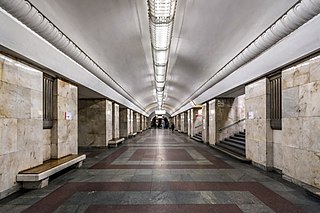
Universitet, named after the nearby Moscow State University, is a station on the Moscow Metro's Sokolnicheskaya Line. It opened in 1959 and has rectangular white marble pylons and tiled walls. The architects were V. Litvinov, M. Markovsky, L. Lile and V. Dobrakovsky. The station's two round entrance vestibules are located on either side of Prospekt Vernadskogo at Lomonosovsky Prospekt.

Kolomenskaya is an underground metro station on the Zamoskvoretskaya Line of the Moscow Metro in Moscow, Russia. It was named after the nearby Kolomenskoye museum-park. The station is situated at the intersection of Andropov avenue, Nagatinskaya and Sudostroitelnaya streets
Leninsky Avenue or Lenin Avenue was a common name for major avenues in many cities of the former Soviet Union commemorating Vladimir Lenin. As of 2020 there were about 20 Leninsky Avenues and over 100 Lenin Avenues in Russia.

Volgogradsky Prospekt is a Moscow Metro station in the Nizhegorodsky District, South-Eastern Administrative Okrug, Moscow. It is on the Tagansko-Krasnopresnenskaya Line, between Proletarskaya and Kuzminki stations. Volgogradsky Prospekt was opened on 31 December 1966 as part of the Zhadovsky radius and is named after the nearby Avenue that leads on from the centre of Moscow into an intercity highway all the way to the southwest of Russia, although not directly to Volgograd. The station was built to a slight modification of the standard 1960s pillar-trispan decoration showing the first signs of innovative design, as architects V. Polikarpova and A. Marova did. The platform is narrowed. The white ceramic tiles on the walls are arranged on 45 degrees to the platform and are decorated with metallic artworks out of anodized aluminium depicting the Battle of Stalingrad. The pillars are faced with white marble whilst the floor with grey granite. The station has two underground vestibules with glazed concrete pavilions which allow passengers access to the Talalikhin and Novostapovskaya streets as well as directly to the AZLK automobile plant..

Tekstilshchiki is a Moscow Metro station in the Tekstilshchiki District, South-Eastern Administrative Okrug, Moscow. It is on Tagansko–Krasnopresnenskaya line, between Volgogradsky Prospekt and Kuzminki stations. Tekstilschiki was opened on 31 December 1966 as a part of the Zhdanovsky radius. The station is situated next to Tekstilshchiki railway station at the intersection of Volgogradsky avenue and Lyublinskaya street. A transfer to Tekstilshchiki is planned.

Leningradsky Prospekt, or Leningrad Avenue, is a major arterial avenue in Moscow, Russia. It continues the path of Tverskaya Street and 1st Tverskaya-Yamskaya Street north-west from Belorussky Rail Terminal, and changes the name once again to Leningrad Highway past the Sokol metro station. The Highway continues its way to Saint Petersburg via Tver.

The M10 "Russia" is a federal highway in Russia connecting the country's two largest cities, Moscow and Saint Petersburg. Other than in the vicinity of Moscow and Saint Petersburg, the M10 is basically a two-lane highway, with an occasional third centre lane to allow overtaking or for left-turning traffic at intersections.
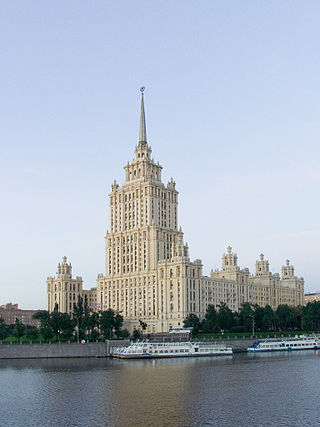
Kutuzovsky Prospekt is a major radial avenue in Moscow, Russia, named after Mikhail Illarionovich Kutuzov, leader of the Russian field army during the French invasion of Russia of 1812. The prospekt continues a westward path of Vozdvizhenka Street and New Arbat Street from Novoarbatsky Bridge over the Moskva River to the junction with Rublyovskoye Shosse; past this point, the route changes its name to Mozhaiskoye Shosse.

Leninsky Avenue is a major avenue in Moscow, Russia, that runs in the south-western direction between Kaluzhskaya Square in the central part of the city through Gagarin Square to the Moscow Ring Road. It is a part of the M3 highway which continues from Moscow to Kaluga and Bryansk to the border with Ukraine, and used to provide connections with Kyiv and Odesa. It is also a part of the European route E101 connecting Moscow and Kyiv.

The Embassy of the Democratic People's Republic of Korea in Moscow is the chief diplomatic mission of North Korea in the Russian Federation. It is located at 72 Mosfilmovskaya Street in the Ramenki District of Moscow at the corner of Mosfilmovskaya Street and Lomonosovsky Prospekt.
Druzhby Street is a street in Ramenki District, West Administrative District, Moscow. The name literally means the street of friendship and apparently commemorates the good moments in the Soviet-Chinese ties, and now China-Russia relations, since the embassy of the People's Republic of China is a major landmark of the street.
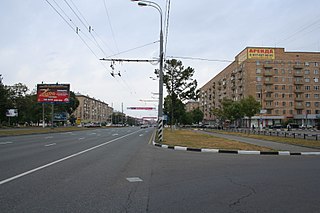
Lomonosovsky District, Moscow is an administrative district (raion) of South-Western Administrative Okrug, and one of the 125 raions of Moscow, Russia. The area of the district is 3.34 square kilometers (1.29 sq mi). Population: 85,000 . Population - 81,851. Established at 1995. Named after Mikhail Vasilyevich Lomonosov.

Academician Sakharov Avenue is a street in the center of Moscow, in Krasnoselsky District. In the south, the street is limited by Turgenevskaya Square and the Boulevard Ring. In the north, Academician Sakharov Prospect ends at the T-shape crossing with Kalanchyovskaya Street, close to Komsomolskaya Square. In the middle, it crosses the Garden Ring.

Ramenki is a station on the Kalininsko-Solntsevskaya Line of the Moscow Metro. It opened on March 16, 2017. as part of the line's current southwestward extension from Park Pobedy. It served as the western terminus of the line, until 2018 with the opening of the extension to Rasskazovka. Tunnelling between the station and that preceding it and following it, Lomonosovsky Prospekt and Michurinsky Prospekt, started in 2013.
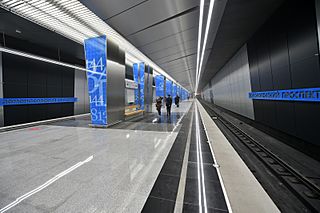
Lomonosovsky Prospekt is a station on the Kalininsko-Solntsevskaya Line of the Moscow Metro. It opened on 16 March 2017 as part of the line's extension between Park Pobedy and Ramenki. Tunneling between the station and that next from it, Ramenki, started in 2013.
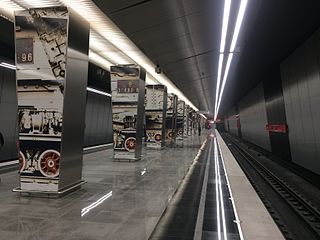
Minskaya is a station of the Kalininsko-Solntsevskaya Line of the Moscow Metro between Lomonosovsky Prospekt and Park Pobedy. The station was opened on 16 March 2017 as a part of the stretch between Park Pobedy and Ramenki.

Nakhimovsky Prospekt is an avenue in Moscow, Russia, that runs from Kolomensky Proyezd in the east to Vavilova Street in the west. After that, it continues as Lomonosovsky Prospekt.


















